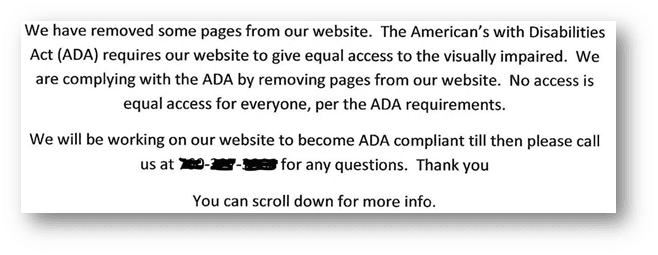Website ADA Compliance

How Business Websites Can Avoid an ADA Lawsuit
A growing roster of businesses have been snared by ADA lawsuits targeting websites. The Trump administration’s unfortunate decision to stop drafting rules for website ADA compliance leaves the marketplace vulnerable to a potential tidal wave of legal action.

Some websites having already experienced ADA lawsuits levied against them now have ugly disclaimers front and center on their homepage pushing down valuable information about their actual business below the fold, which is a form of Siberia for website content:

From http://www.avantihotelps.com
Breaking News 2019 - A class action lawsuit has been filed in New York on Thursday (1/3/2019) against Beyoncé’s company Parkwood Entertainment claiming its website denies equal access to visually impaired users. A blind woman named Mary Conner argues Beyonce.com has no alt-text coded behind its photos, which violates the Americans with Disabilities Act. There were 1,053 such suits filed during the first six months of 2018. As the best protection is good prevention, here is what to know about ADA website violations and what is needed to be in compliance, so as to avoid potential lawsuits and content modifications to your website that would obscure your primary business purpose.
What is ADA Website Compliance?
The goal of the 1990Americans with Disabilities Act (ADA) is removing barriers preventing a disabled person from accessing facilities, services, and benefits akin to a non-disabled person. As a result, while businesses have made physical plant adjustments such as installing wheelchair ramps, many still don’t realize their websites should also be aligned with the ADA.The key tenant for ADA website compliance relates to if the website can be used by people who have problems seeing or hearing. As such, an initiative by a consortium of web innovators has published the Web Content Accessibility Guidelines (WCAG), which addresses how to tweak business websites; typically stocked with images and video; the type of assets that tend to be more difficult to modify.
Compliance Steps
The key is what’s termed WCAG compliance testing. WCAG defines how to make web content more accessible to people with a wide range of disabilities including visual, auditory, physical, speech, cognitive, language, learning, and neurological disabilities.For a website to be deemed accessible the content must be coded so screen-reading software can convert the words to an audio translation. Video that appears on a website must include descriptions for the deaf and images must have ALT text embedded in the code. All interactive functions must be operable through keyboard commands for people who can’t use a mouse. Color contrast needs to be verified to be in compliance. Proper HTML website code semantics must be in place in a manner where a computer screen reader can understand the web page document on behalf of a blind person.
Is My Website at Risk?
Consult a checker, such as: https://achecker.ca/checker/index.php – punch in a URL, specify what level of WCAG you want (though version 2.1 is not yet supported), and it will generate a report:

Development Agencies Can Remedy
Website development agencies can be enlisted to perform the necessary WCAG compliance testing and proceed to then make the assessed modifications. Most modifications will have no bearing on the general look, feel, and functionality of the site, but will be essential to the underlying codebase in a manner impacting how effectively and comprehensively the website conveys the same information to the tools used by a disabled visitor to that site.
